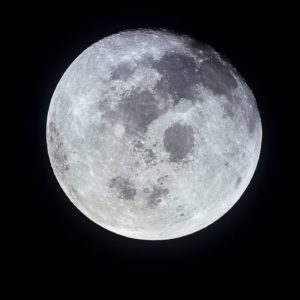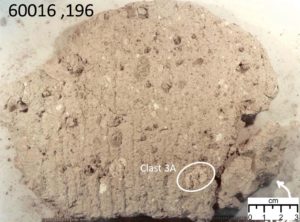16 October 2019
Ancient Moon rock provides evidence of giant lunar impact 4.3 billion years ago
Posted by Lauren Lipuma

New research finds evidence of an ancient impact 4.3 billion years ago on the Moon, churning rock up to the lunar surface.
Credit: NASA.
By Abigail Eisenstadt
An Apollo 16 lunar rock sample shows evidence of intense meteorite bombardment on the Moon 4.3 billion years ago, according to new research. The results provide new insights for the Moon’s early history, showing lunar impacts were common throughout the Moon’s formation than previously thought.
When the Moon first formed, its surface was covered in a sea of molten rock called the lunar magma ocean. This magma ocean eventually cooled and formed the rocks that make up the lunar crust and mantle.
A new study in AGU’s Journal of Geophysical Research: Planets analyzed a Moon rock from the Apollo 16 mission and found the rock cooled quicker than expected. The results suggest that 4.3 billion years ago a previously unidentified impact event forced the rock from the depths of the slowly cooling lunar crust to the surface.
“Something hit the Moon while the rocks were still at high temperatures, excavated the rock from depths in the lunar crust, and then it cooled quickly after that,” said Naomi Marks, a geochemist at Lawrence Livermore National Laboratory in Livermore, California and lead author of the new study.
Many planetary scientists had previously accepted the idea that the Moon had a relatively peaceful existence following its creation until the Late Heavy Bombardment, a period when the Moon was intensely pelted by meteorites and asteroids 4.0 billion to 3.8 billion years ago. But scientists have been questioning the accuracy of this theory. The new results add to growing evidence that the theory may be incorrect by identifying a major impact outside of the theory’s timeframe, according to the study’s authors.
“We are fairly confident that that the age is recording an impact, which means that there were significant impacts outside of the Late Heavy Bombardment period,” Marks said.
Understanding ancient lunar impacts could help scientists uncover more information about the early Moon’s formation and its surroundings.

Clast 3A refers to the area sampled from the anorthosite rock called 60016. The rock shown here was brought back during the Apollo 16 mission.
Credit: AGU.
Forming rocks from magma
The Moon is thought to have originated from debris created by a collision between an ancient Mars-sized planet and Earth. During its initial period of formation, the Moon’s surface was an ocean of magma. Eventually, heavier elements began to sink to the depths of the ocean, forming the solid lunar core around 4.4 billion years ago. Then the outer layer comprised of lighter material began to rise to the top and cool. This formation of the lunar crust is estimated to have taken between 10 million and 250 million years.
Studying the lunar crust allows scientists to learn more about the Moon’s origins and evolution. One type of lunar surface rock, called anorthosites, are responsible for the Moon’s bright white color and were once thought to be the oldest rocks on the lunar surface.
In the new study, Marks and her colleagues wanted to use anorthosites to estimate how long it took for the lunar magma ocean to cool and solidify into rocks. They took a sample from a previously unexamined anorthosite collected by the Apollo 16 mission and analyzed isotopes produced by the radioactive decay of elements within the rock to determine when it cooled to certain temperatures.
They found the rock went from around 855 degrees Celsius (1,571 degrees Fahrenheit) to roughly 250 degrees Celsius (482 degrees Fahrenheit) within a few thousand years – an unusually quick cooling rate in the scheme of other planetary timescales. The rapid cooling indicates a major impact likely propelled rock out of the lower crust to the surface, where it rapidly cooled into anorthosite alongside other rocks, according to the authors.
The study provides good evidence for a large impact on the Moon 4.3 billion year ago, adding to many decades of research on lunar chronology, said Kevin McKeegan, a planetary scientist at the University of California, Los Angeles in Los Angeles, California, who was unaffiliated with the study.
Evidence for the ancient lunar impact reveals how tumultuous the Moon’s early period was, helping scientists understand more about its formation and composition, according to Marks.
— Abigail Eisenstadt is a science writing intern at AGU. Follow her on twitter @aeisenstadt1










 GeoSpace is a blog on Earth and space science, managed by AGU’s Public Information staff. The blog features posts by AGU writers and guest contributors on all sorts of relevant science topics, but with a focus on new research and geo and space sciences-related stories that are currently in the news.
GeoSpace is a blog on Earth and space science, managed by AGU’s Public Information staff. The blog features posts by AGU writers and guest contributors on all sorts of relevant science topics, but with a focus on new research and geo and space sciences-related stories that are currently in the news.